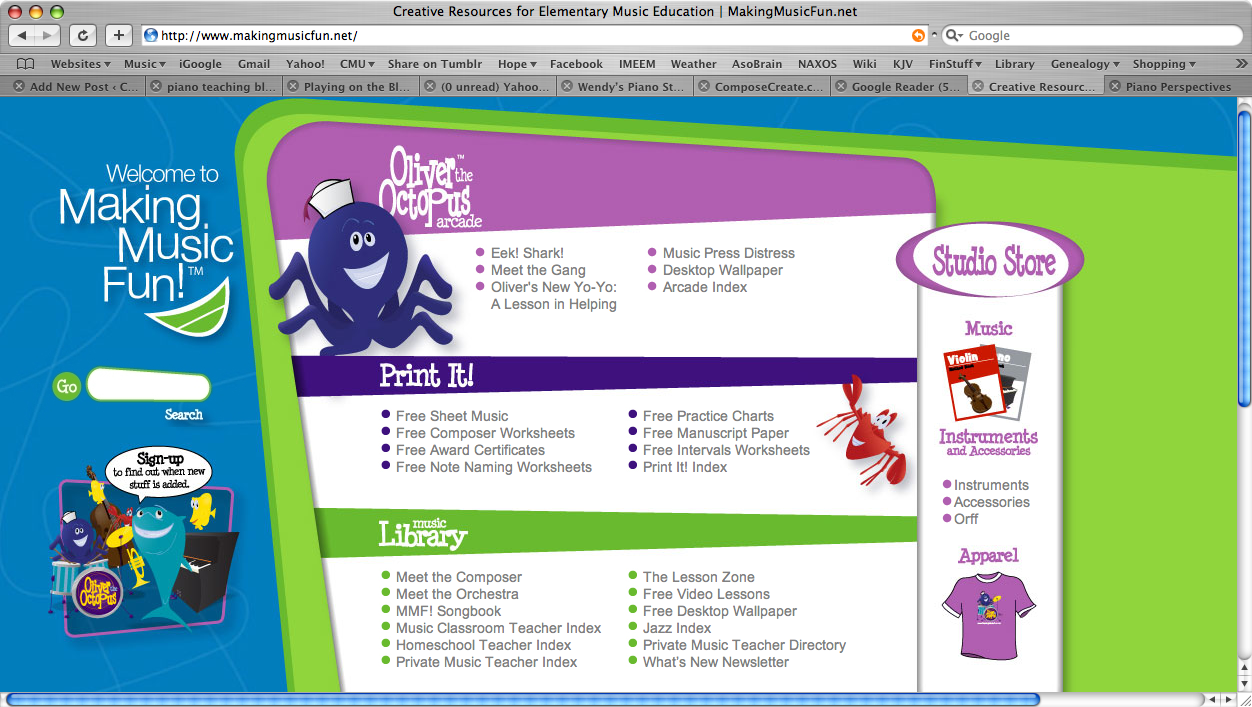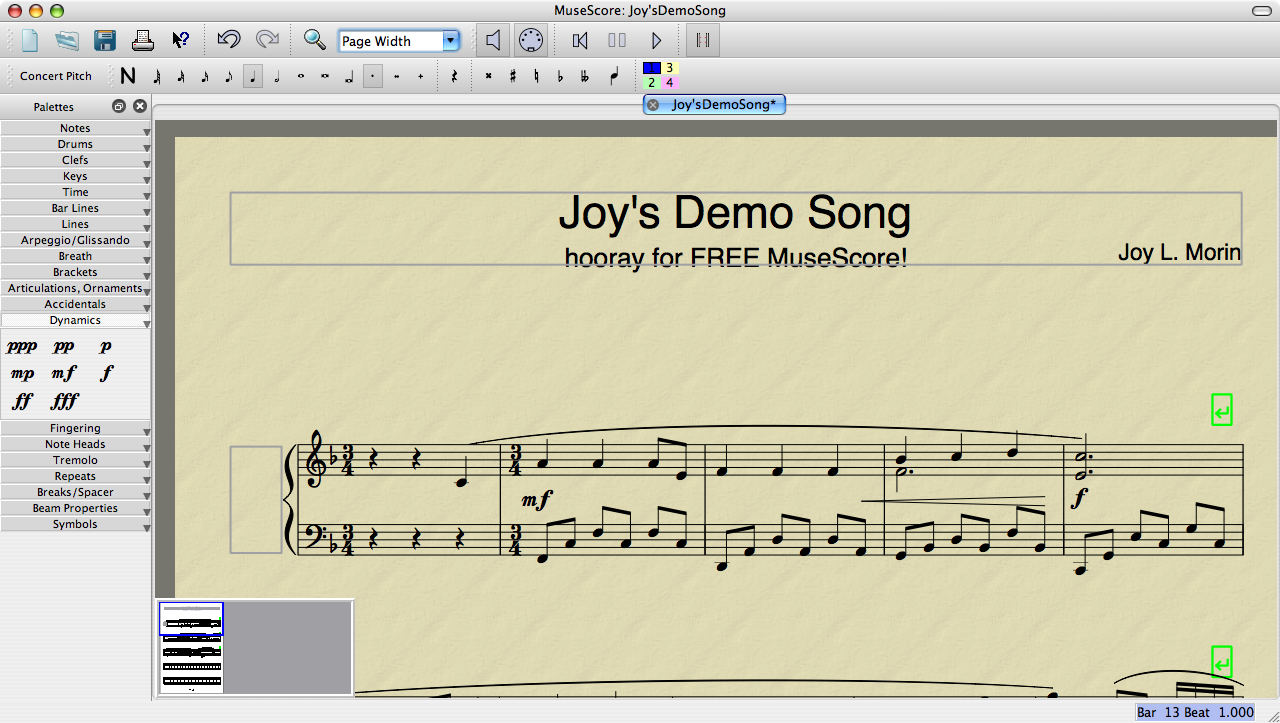If you like new age or solo piano music, check out Whisperings: Solo Piano Radio. You can listen to new age / solo piano music for free on their website. It’s a great place to listen to relaxing piano music while checking email or surfing the web. =)
Category: Resources
Free Sheet Music @ pianostreet.com
 Free sheet music is always a good thing, right? :]
Free sheet music is always a good thing, right? :]
By signing up for a free Silver membership over at pianostreet.com, you’ll have access to free pdfs of classical music scores, including:
- Bach – 15 Inventions
- Beethoven – 32 Sonatas
- Burgmuller – 3 pieces from 25 Easy and Progressive Studies
- Schumann – Traumerei
- Tchaikovsky – 2 pieces from Album for the Young
- . . .and other random pieces by composers such as Mozart, Clementi, Listz, and Brahms — including an arrangements of Pachelbel’s Canon in D and Rimsky-Korsakov’s Flight of the Bumblebee.
If you upgrade to a Gold Membership, you’ll have access to even more music. Personally, I am planning to stick with my free Silver membership. I am thrilled to be able to print (for free!) these great classics for my students, particularly for the ones with little money to spare for piano lessons during these rough economic times.
Resources @ makingmusicfun.net
Have you seen makingmusicfun.net yet? This site is full of free resources for both teachers and students. All the materials available at Making Music Fun have super-cute graphics in an “under the sea” theme.
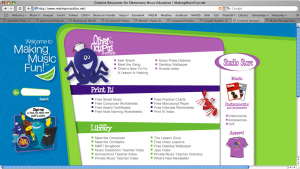
For teachers:
- Sheet music (both arranged and unarranged, organized by level)
- Composer worksheets
- Music achievement certificates
- Practice charts
- Manuscript paper
- Intervals worksheets
- and more!
For kids:
- Music theory arcade games
- “Meet the composer” section
- “Meet the orchestra” section
- Children’s songs
There’s plenty to explore at the Making Music Fun website. Let me know what you find!
Best free manuscript paper
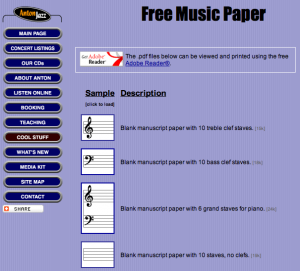 Just thought I’d share a little tip today about where to find THE best free manuscript paper (in my humble opinion): Antonjazz.com
Just thought I’d share a little tip today about where to find THE best free manuscript paper (in my humble opinion): Antonjazz.com
There are hundreds of sites out there that offer free manuscript paper (aka staff paper). But this is my absolute favorite.
Now, you must know, I do a little composing every now and then. And I have discovered that I am a very picky manuscript paper person. It has to be just right.
I always print the “Blank manuscript paper with 10 staves, no clefs” paper. It’s very economical and flexible. It’s professional and clean-looking.
Does this paper work for young students? Not so much. I’d recommend finding something bigger. With wider spaces. (Suggestions, anyone?)
But I love this manuscript paper for myself and my older students to use. It’s perfect for that.
—————
Do you have a favorite manuscript paper, as I do? Please let us know by commenting below.
Value of Teaching to Play By Ear
A couple weeks ago, I posted a list of melodies that work well assign piano students to take home and learn to play by ear. Over at ComposeCreate.com, Wendy Stevens talks about the value of teaching students to play by ear during a lecture she gave, Composition for Kids: Time-Saving Ways to Teach Composition in your Studio. (If you haven’t already, you really should check out the entire series of videos she has posted — they contain some very practical ways to encourage and teach composition in the piano lesson.)
Wendy also created a great handout that you can give to your students, to assign them tunes to play by ear, harmonize it, transpose it, and do something creative with it. This handout is available on this post (the link to the actual handout is located just underneath the video). Be sure to check it out!
Book Review: Soprano on Her Head
I just finished reading a marvelous book, called Soprano on Her Head: Right-Side-Up Reflections on Life and Other Performances, by Eloise Ristad. My piano professor recommended I read this book during a lesson when we were discussing performance anxiety (which I experience frequently, I must admit).
In this easy-to-read, humorous book, Ristad shares her experiences and ideas gained through teaching/coaching musicians and leading performance anxiety workshops. The book contains 16 chapters, each of which is self-contained (thus the chapters can be read in any order). I would recommend this book to any music teacher or musician looking for light reading that is useful and humorous — especially to anyone seeking to become more knowledgeable in ways to deal with performance anxiety.
Some things that struck me the most in this book:
- When musicians perform, they sometimes allow the “judges” in their head to talk and increase their nervousness. Ristad discusses ways to get beyond these judges and perform with less anxiety.
- Ristad discusses the close connection between music and movement. She also mentions how movement is much more adequate when describing music than words are. Just think how much time and energy we could save during lessons if we used fewer words and more movement to communicate to the student!
- When it comes to practicing, quality beats quantity. That is, it is more important that we as musicians practice effectively, with more awareness, than that we spend 6 hours a day locked up in a practice room. Ristad mentions some specific ways how make practice time more effective.
- Ristad speaks of enjoying the journey, not just the destination. I am so guilty of this. The end performance isn’t everything. The whole process of taking piano lessons would be SO much more enjoyable if I enjoyed the time spent learning my pieces too. Besides, doing this makes it so that you’ve already “won”, whether or not the actual performance goes well or not.
- Once during a lesson with a student who had struggled with reading music for years, Ristad impulsively turned the music on its side, so the staff was vertical. A light bulb turned on in the students mind, and suddenly everything her past teachers had told her about intervals and up/down on the keyboard made sense. If you think about it, a vertical staff makes more sense because each line/space can easily be correlated with the piano keys when you glance down. Interesting . . . I may have to try this on a few of my students sometime.
- Ristad discussed the value of visualizing. It may be valuable to learn piano music away from the piano, by studying the score and visualize yourself playing it on the piano. This is a good memorizing technique as well.
- I appreciated Ristad’s perspective upon technique. It’s easy to become sold by a particular technique for playing the piano, especially after reading amazing conversion stories by influential musicians. But is there really ONE correct way? I prefer learning what I can from ALL the different techniques I encounter, and incorporating small bits of each one into my own methodology.
I highly recommend this book to anyone looking for fun ideas to use in private or group lessons, or to any fellow musician who experiences performance anxiety. It was an incredibly enjoyable book to read.
My rating: 5 stars (out of 5 stars)
Earn 8% when you order sheet music
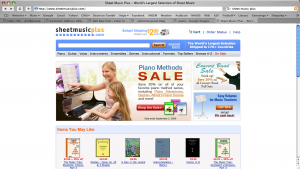 Sheet Music Plus has begun a new promotional program for music teachers to earn 8% back in rebates when they or their students order from SheetMusicPlus.com. I was thrilled to hear about this program last week, because I just so happened to need a few music books!
Sheet Music Plus has begun a new promotional program for music teachers to earn 8% back in rebates when they or their students order from SheetMusicPlus.com. I was thrilled to hear about this program last week, because I just so happened to need a few music books!
Other perks:
- $2.99 budget shipping.
- Going on now: save 20% on piano method series (ends September 2).
So sign up now, and start earning 8% back in rebates when you order your sheet music!
Playing-By-Ear Activities
Learning to play by ear is one of the most natural ways to develop the ear – and one of the most fun! Below are some lists of familiar tunes you can assign at the lesson for the student to learn to play by ear. I found this valuable information about playing-by-ear activities to assign students in the book, Professional Piano Teaching, by Jeanne Jacobson. I hope you find this information as useful as I did.
What to tell the student:
- Where to begin. Example: “Start with finger 3 on Middle C.”
- The first interval. Example: “The first interval is a fourth.”
- Which keys they will use to play the song. Example: “You will be using the notes A, B, and C.” Continue reading “Playing-By-Ear Activities”
Gabriela Montero: pianist/improviser
Have you seen the some of the incredible improvised performances by Gabriela Montero on YouTube? Not only is she an accomplished classical pianist, but she’s an incredible improviser as well. In this video, she took a request from the audience to improvise upon the theme from J.S. Bach’s Goldberg Variations:
According to her website, she takes online requests as well — and performs improvisations live from her living room bi-weekly. Be sure to read the bio on her website; it’s quite interesting to read about her background.
On a more personal note (pun intended), I am currently taking a Music Research class at college. Our first assignment is to come up with topic ideas for a paper we’ll be working on all semester. One of the ideas I have is to discuss how today’s modern performance practices differ from Romantic 19th Century performance practices — particularly, the decline of improvisation among pianists. In the days of Listz and Clara Schumann, improvisation was a standard part of a performance. And when pianists did perform a piece composed by someone else, it was usually modified beyond recognition. Why is it that most modern pianists do not improvise ever — much less during a performance? I would like to research the causes that would explain may have contributed to this decline.
Gabriela Montero seems to be a major exception, however. Her talent in improvisation is incredible. It may be one of the contributing factors to her popularity as a pianist. I was pleased to come across her name this week as I contemplate topic ideas. What do you think?
A Closer Look at MuseScore: FREE music notation software

Move over, Finale and Sibelius! There’s somebody new in town. MuseScore is a music notation software available FREE online for anyone to download. After doing a brief test drive last spring (mentioned here), I decided to take a closer look now that it’s available for Mac users.
I’ve been a faithful Finale user since 2005, mainly because Finale is the software of choice at the colleges I’ve attended. I use Finale to make worksheets for my students and to notate my original compositions and arrangements. Buying Finale 2009 last September cost me an arm and a leg, so I was quite curious to see how MuseScore would compare. Is it worth spending all that money on Finale when you can get MuseScore for free? Continue reading “A Closer Look at MuseScore: FREE music notation software”
MuseScore: free music notation software
Have you heard about the new free music notation software called MuseScore? I have heard nothing but favorable reviews about it thus far. Personally, I do not currently have a great need for it, since I use Finale software at college. But this may very well be a great resource for teachers who do not wish to invest in expensive music notation software (let me tell you, Finale costs an arm and a leg!) or, for students who have an interest in composition. I was glad to hear about MuseScore. Ever since Finale started charging ~$10 to download Finale Notepad (a simple, previously-free version of Finale), I have been on-the-lookout for something else to recommend to my students.
Mac users are unfortunately out of luck, because MuseScore is currently only available for PC’s. [Correction: MuseScore IS indeed now available for Macs. Sorry for the misinformation!] I breifly tried out this software on my husband’s PC, and it seems to be fairly user-friendly. If you are looking for an inexpensive alternative to Finale or Sibelius, MuseScore is worth a look!
[Now that MuseScore is available for Macs, I plan to download it and blog more about it soon. Check back soon!]
“New” works by Mozart
Perhaps you’ve heard some of the commotion about the discovery of some “new” works by Mozart. Pretty exciting stuff! Check out the movie below:
I enjoyed hearing this piece played on an instrument from the time period. It really changes your perspective on the music.
In addition:
- Listen to “the premiere” of a Mozart chamber music (from the same performance), also available on youtube, by clicking here.



